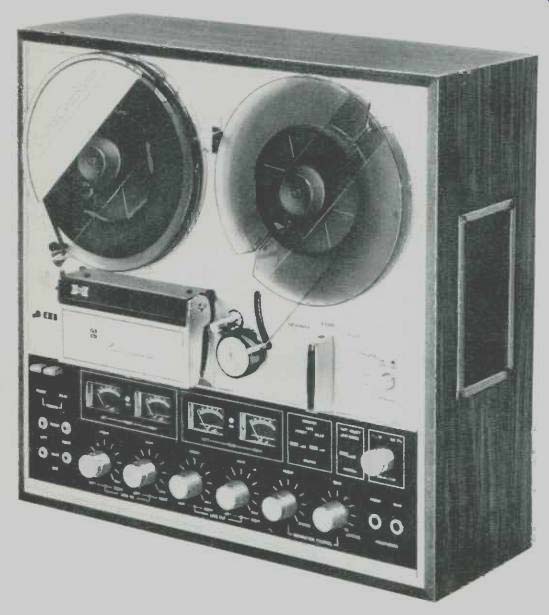
Manufacturer's Specifications
Tracks; 4, quadraphonic.
Speeds: 3 3/4 and 7 1/2 ips.
Frequency Response: 30 to 23,000 Hz at 7 1/2 ips; 30 to 20,000 3 dB.
Wow and Flutter: Less than 0.1% at 7 1/2 ips; less than 0.13% at 3 3/4 ips.
Inputs: Mic,-65 dB (4 circuits) 5k to 20k ohms impedance; line, -30 dB, 220k ohms impedance. Output: Line, 10.000 ohms impedance; headphones, 8 ohms.
Dimensions: 16 3/4 in. W. x 15 3/4 in. H. x 8 in. D.
Price: $449.95.
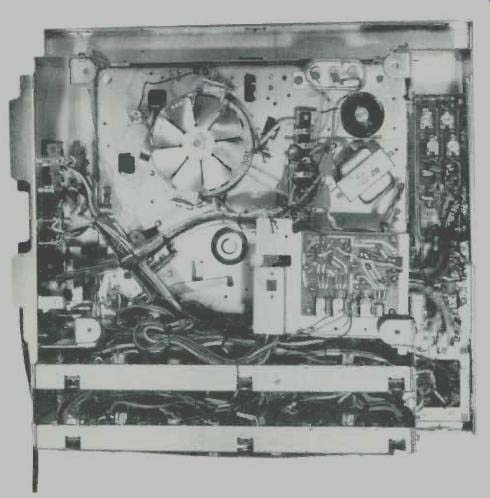
Fig. 1--Showing the underneath view.
The RS-740US is a quadraphonic tape deck having a good all-round performance for its modest price of $449.95. It is one of the first products to be designated Technics by Panasonic, a name designating top quality equipment for the audiophile. The first thing that strikes the eye is the neat row of six knobs at the bottom. Reading from the left, the first pair are dual-concentric types controlling the input signal. The next pair are also dual concentric and they control the output. The third pair are labeled "separation," and they can blend the front and rear channels. If both are turned to maximum, then the front and back pairs form a double two-channel. To the right are two headphone sockets, and at the extreme left are four microphone input sockets. Above these are the record switches and the usual digital counter. To the right of the meters are the tape selector and the equalizer switches. The tape selector enables either normal or low-noise tape to be used, and the equalizer switch has to be used in conjunction with the two-position speed selector switch which is located at the top, between the two reels.
The large knob above the tape selector is the function lever and it controls the playback, record, fast-forward, reverse, pause, and stop functions. To the right is the push button ON/OFF switch. In a recess on the right hand side of the machine is a panel on which the input and output sockets (including DIN) are located. Also on this panel are output sockets for 'scope monitoring. Figure 1 shows the view underneath, and the head assembly is seen in Fig. 2. A single motor is used-a four-pole induction type.

Fig. 2--Head assembly.
Circuit Details
The basic design is fairly straightforward, with four record and four playback amplifiers. The basic circuit for a playback amplifier is shown in Fig. 3. R, forms a d.c. stabilizing loop between the emitter of T2 to the base of T3. The capacitor C1 prevents a.c. feedback. The network VR1, VR2, C1, C2, and R2 form a frequency-selective, negative-feedback loop for equalization. The next two stages, T, and T., both have current feedback in the emitter circuit (C5 is only 0.01 µF), and the line and scope outputs are taken from the collector of T4. T5 is an emitter-follower feeding the VU meter and headphone transformer.
A total of 36 transistors are used-plus two in the push-pull bias oscillator and another in the stabilized power supply.
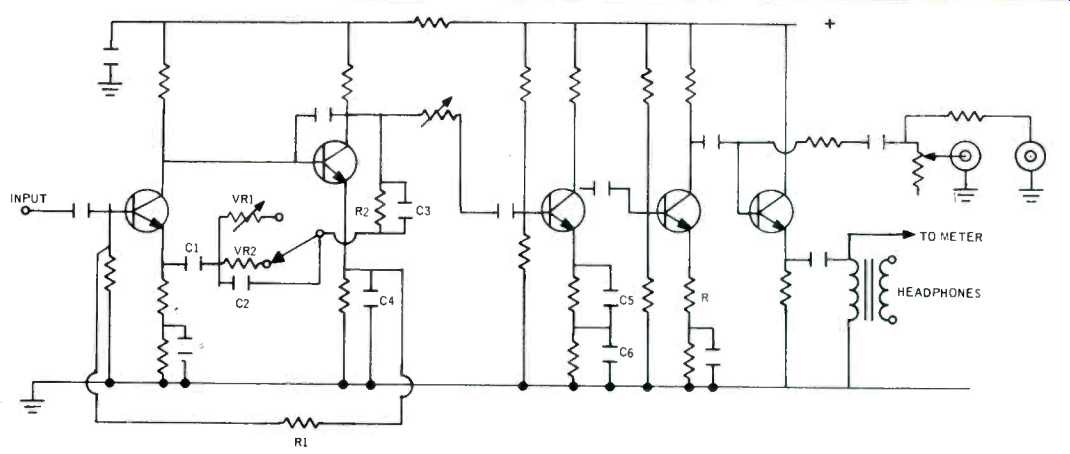
Fig. 3--Basic circuit of a playback amplifier.
Measurements
Figure 4 shows the record replay response at 7 1/2 ips; the upper solid-line curve was taken at-20 VU and the broken line shows the response at 0 VU. Response at 3 3/4 ips is shown at B for both levels. It will be seen that the 3 dB point is at 24 kHz at 7 1/2 ips and 13 kHz for 3 3/4 ips-very creditable. The response from a standard playback tape is given in Fig. 5. Distortion at 0 VU measured 0.8% at 1 kHz and increased to 1.4% at +3 dB, as can be seen from Fig. 6. THD versus frequency is shown in Fig. 7. Signal-to-noise ratio measured 59 dB referred to 0 VU or 63.5 dB referred to the 3% distortion figure. Incidentally, the tape used for these tests was Maxell UD, but similar results were achieved with TDK SD and BASF 35.
Wow and flutter is specified as less than 0.10% at 7 1/2 ips. Our measurements came very close with 0.12% at 7 1/2 ips and 0.14% at 3 3/4 ips. Input sensitivity was 27 mV for 0 VU and the output was 500 mV.
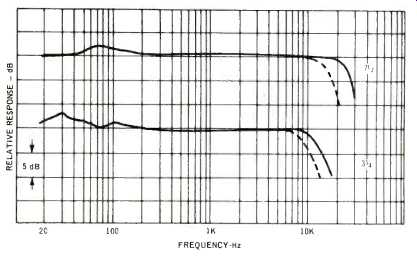
Fig. 4--Record-playback response at 7 1/2 and 3 3/4 ips.
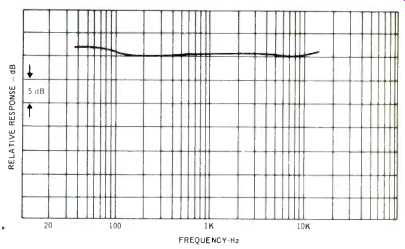
Fig. 5--Response from standard playback tape.
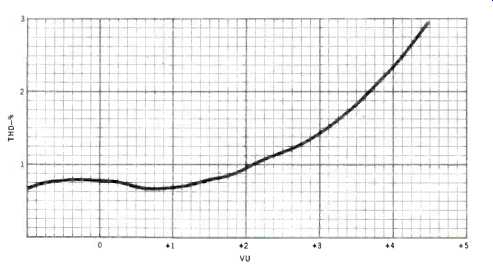
Fig. 6--Distortion at 1 kHz.
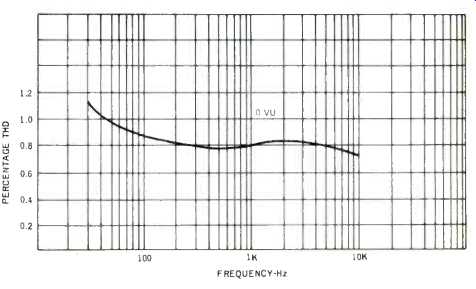
Fig. 7--TH D versus frequency.
Listening Tests
For our tests we used the 740 with a Technics by Panasonic SA 6800X four-channel receiver and four EPI 100s. We found the deck easy to use, and the controls were smooth and positive. The monitoring facility is, of course, almost essential for the serious recording enthusiast, as is the provision for low-noise tapes. In fact, the reason why the overall results were better than the specifications might be due to the use of these tapes. Be that as it may, a distortion of less than 1% at 0 VU with a frequency response only 3 dB down at 24 kHz compares very favorably with machines costing much more. And the 740 is a four-channel deck into the bargain! Quadraphonic sound is an exciting field for the enthusiast-there are all kinds of recording methods to be tried: spaced mics, co-axial, omnidirectional, cardioid, and so on. And, don't forget, you can play your ordinary two-channel tapes on the 740 as well.
-G. W. T.
=================
(Adapted from Audio magazine, Jul. 1973)
Also see:
Technics by Panasonic SA-8000X 4-Channel/2-Channel Receiver (Nov. 1974)
Teac X-20R Open-Reel Recorder (Equip. Profile, Mar. 1982)
TEAC 3340 Open-reel tape recorder (Mar. 1973)
TEAC Model C-1 Cassette Deck (Dec. 1979)
Technics SV-P100 Digital Audio Cassette Recorder (Apr. 1982)
Technics Model RS-616 Cassette Deck (Feb. 1979)
= = = =